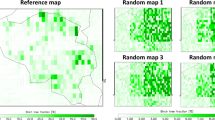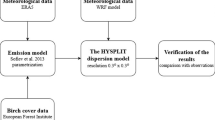Abstract
In Belgium, ~ 10% of the people is estimated to suffer from allergies due to pollen emitted by the birch family trees. Timely information on forthcoming pollen exposure episodes using a forecasting system can allow patients to take preventive measures. To date, the only available information on pollen concentrations in Belgium comes from five stations that monitor daily airborne birch pollen concentrations, but real-time and detailed spatial information is lacking. Pollen transport models can both quantify and forecast the spatial and temporal distribution of airborne birch pollen concentrations if accurate and updated maps of birch pollen emission sources are available and if the large inter-seasonal variability of birch pollen is considered. Here we show that the SILAM model driven by ECMWF ERA5 meteorological data is able to determine airborne birch pollen levels using updated maps of areal fractions of birch trees, as compared to the pollen observations of the monitoring stations in Belgium. Forest inventory data of the Flemish and Walloon regions were used to update the default MACCIII birch map. Spaceborne MODIS vegetation activity combined with an updated birch fraction map and updated start and end dates of the birch pollen season were integrated into SILAM. The correlation (R2) between SILAM modelled and observed time series of daily birch pollen levels of 50 birch pollen seasons increased up to ~ 50%. The slopes of the linear correlation increased on average with ~ 60%. Finally, SILAM is able to capture the threshold of 80 pollen grains m−3 exposure from the observations.









Similar content being viewed by others
References
Blomme, K., Tomassen, P., Lapeere, H., et al. (2013). Prevalence of allergic sensitization versus allergic rhinitis symptoms in an unselected population. International Archives of Allergy and Immunology,160(2), 200–207.
Bruffaerts, N., De Smedt, T., Delcloo, A., et al. (2018). Comparative long-term trend analysis of daily weather conditions with daily pollen concentrations in Brussels, Belgium. International Journal of Biometeorology,62, 483–491. https://doi.org/10.1007/s00484-017-1457-3.
Busetto, L., & Ranghetti, L. (2016). MODIStsp: An R package for automatic preprocessing of MODIS Land Products time series. Computers & Geosciences,97, 40–48. https://doi.org/10.1016/j.cageo.2016.08.020.
Clement, J., Maes, P., van Ypersele de Strihou, Ch., van der Groen, G., Barrios, J. M., Verstraeten, W. W., et al. (2010). Beechnuts and outbreaks of nephropathia epidemica (NE): Of mast, mice and men. Nephrology, Dialysis, Transplantation,25, 1740–1746. https://doi.org/10.1093/ndt/gfq122.
D’Amato, G., Cecchi, L., Bonini, S., et al. (2007). Allergenic pollen and pollen allergy in Europe. Allergy,62, 976–990. https://doi.org/10.1111/j.1398-9995.2007.01393.x.
Dujardin, S., Linard, C., & Dendoncker, N. (2017). Research note on mapping allergenic tree species in Belgium. BR/154/A1/RespirIT, Belgian research action through interdisciplinary networks.
ECMWF. Retrieved June–July, 2018 from https://www.ecmwf.int/en/newsletter/147/news/era5-reanalysis-production.
Galán, C., Ariatti, A., Bonini, M., Clot, B., Crouzy, B., Dahl, A., et al. (2017). Recommended terminology for aerobiological studies. Aerobiologia,33, 293–295. https://doi.org/10.1007/s10453-017-9496-0.
Galán, C., Smith, M., Thibaudon, M., et al. (2014). Pollen monitoring: Minimum requirements and reproducibility of analysis. Aerobiologia,30, 385. https://doi.org/10.1007/s10453-014-9335-5.
Hemery, G. E., Savill, P. S., & Pryor, S. N. (2005). Applications of the crown diameter–stem diameter relationship for different species of broadleaved trees. Forest Ecology and Management,215, 285–294.
Hoebeke, L., Bruffaerts, N., Verstraeten, C., et al. (2018). Thirty-four years of pollen monitoring: An evaluation of the temporal variation of pollen seasons in Belgium. Aerobiologia. https://doi.org/10.1007/s10453-017-9503-5.
Khwarahma, N. R., Dash, J., Skjøth, C. A., Newnham, R. M., Adams-Groom, B., Heade, K., et al. (2017). Mapping the birch and grass pollen seasons in the UK using satellite sensor time-series. Science of the Total Environment,578, 586–600.
Kouznetsov, R., & Sofiev, M. (2012). A methodology for evaluation of vertical dispersion and dry deposition of atmospheric aerosols. Journal of Geophysical Research. https://doi.org/10.1029/2011JD016366.
Linkosalo, T., Ranta, H., Oksanen, A., Siljamo, P., Luomajoki, A., Kukkonen, J., et al. (2010). A double-threshold temperature sum model for predicting the flowering duration and relative intensity of Betula pendula and B. pubescens. Agricultural and Forest Meteorology,150, 6–11. https://doi.org/10.1016/j.agrformet.2010.08.007.
Pauling, A., Rotach, M. W., Gehrig, R., & Clot, B. (2012). A method to derive vegetation distribution maps for pollen dispersion models using birch as an example. International Journal of Biometeorology,56(5), 949–958. https://doi.org/10.1007/s00484-011-0505-7.
Pfaar, O., Bastl, K., Berger, U., Buters, J., Calderon, M. A., Clot, B., et al. (2017). Defining pollen exposure times for clinical trials of allergen immunotherapy for pollen induced rhinoconjunctivitis—An EAACI position paper. Allergy,72, 713–722. https://doi.org/10.1111/all.13092.
Prank, M., Chapman, D. S., Bullock, J. M., Belmonte, J., et al. (2013). An operational model for forecasting ragweed pollen release and dispersion in Europe. Agricultural and Forest Meteorology,182–183, 43–53. https://doi.org/10.1016/j.agrformet.2013.08.003.
Ritenberga, O., Sofiev, M., Kirillova, V., Kalnina, L., & Genikhovich, E. (2016). Statistical modelling of non-stationary processes of atmospheric pollution from natural sources: Example of birch pollen. Agricultural and Forest Meteorology,226–227, 96–107. https://doi.org/10.1016/j.agrformet.2016.05.016.
Ritenberga, O., Sofiev, M., Siljamo, P., Saarto, A., Dahl, A., Ekebome, A., et al. (2018). A statistical model for predicting the inter-annual variability of birch pollen abundance in Northern and North-Eastern Europe. Science of the Total Environment,615, 228–239.
Sciensano. Section of the Belgian aerobiological surveillance network. Retrieved July 9, 2018, from https://airallergy.sciensano.be/.
Siljamo, P., Sofiev, M., Filatova, E., et al. (2013). A numerical model of birch pollen emission and dispersion in the atmosphere. Model evaluation and sensitivity analysis. International Journal of Biometeorology,57, 125–136. https://doi.org/10.1007/s00484-012-0539-5.
Sofiev, M. (2016). On impact of transport conditions on variability of the seasonal pollen index. Aerobiologia,33, 167–179. https://doi.org/10.1007/s10453-016-9459-x.
Sofiev, M., Berger, U., Prank, M., Vira, J., Arteta, J., Belmonte, J., et al. (2015a). MACC regional multi-model ensemble simulations of birch pollen dispersion in Europe. Atmospheric Chemistry Physics,15, 8115–8130.
Sofiev, M., Siljamo, P., Ranta, H., Linkosalo, T., Jaeger, S., Rasmussen, A., et al. (2013). A numerical model of birch pollen emission and dispersion in the atmosphere. Description of the emission module. International Journal of Biometeorology,57, 45–58. https://doi.org/10.1007/s00484-012-0532-z.
Sofiev, M., Siljamo, P., Ranta, H., & Rantio-Lehtimäki, A. (2006). Towards numerical forecasting of long-range air transport of birch pollen: Theoretical considerations and a feasibility study. International Journal of Biometeorology,50, 392–402. https://doi.org/10.1007/s00484-006-0027-x.
Sofiev, M., Vira, J., Kouznetsov, R., Prank, M., Soares, J., & Genikhovich, E. (2015b). Construction of the SILAM Eulerian atmospheric dispersion model based on the advection algorithm of Michael Galperin. Geoscientific Model Development,8, 3497–3522. https://doi.org/10.5194/gmd-8-3497-2015.
Spieksma, F. Th. M., Emberlin, J. C., Hjelmroos, M., Jäger, S., & Leuschner, R. M. (1995). Atmospheric birch (Betula) pollen in Europe: Trends and fluctuations in annual quantities and the starting dates of the seasons. Grana,34(1), 51–57. https://doi.org/10.1080/00173139509429033.
Tanentzap, A. J., & Monks, A. (2018). Making the mast of a rainy day: Environmental constraints can synchronize mass seeding across populations. New Phytologist,219, 6–8. https://doi.org/10.1111/nph.15219.
Verstraeten, W. W., Boersma, K. F., Douros, J., Williams, J. E., Eskes, H., Liu, F., et al. (2018). Top-down NOX emissions of European cities based on the downwind plume of modelled and space-borne tropospheric NO2 columns. Sensors,18, 2893. https://doi.org/10.3390/s18092893.
WAO. World Allergy Organization. How are you managing pollen allergies in a changing global climate? Retrieved July 9, 2018, from www.worldallergy.org/UserFiles/file/waw16-slide-set.pdf.
WHO. (2003). Phenology and human health: Allergic disorders. Copenhagen: WHO.
Yli-Panula, E., Fekedulegn, D. B., Green, B. J., & Ranta, H. (2009). Analysis of airborne Betula pollen in Finland; a 31-year perspective. International Journal of Environmental Research and Public Health,6, 1706–1723. https://doi.org/10.3390/ijerph6061706.
Zhao, M., Heinsch, F. A., Nemani, R. R., & Running, S. W. (2005). Improvements of the MODIS terrestrial gross and net primary production global dataset. Remote Sensing of Environment,95, 164–176.
Ziello, C., Sparks, T. H., Estrella, N., Belmonte, J., Bergmann, K. C., et al. (2012). Changes to airborne pollen counts across Europe. PLoS ONE,7(4), e34076.
Acknowledgements
This research was partly funded by the Belgian Science Policy Office (BELSPO) in the frame of the Belgian Research Action through Interdisciplinary Networks Brain (BRAIN.be) programme—project RespirIT (BR/154/A1/RespirIT) and partly funded by the Royal Meteorological Institute of Belgium. We acknowledge the discussions with the other members of the RespirIT project.
Funding
This research was partly funded by the Belgian Science Policy Office (BELSPO) in the frame of the Belgian Research Action through Interdisciplinary Networks Brain (BRAIN.be) programme—project RespirIT (BR/154/A1/RespirIT) and partly funded by the Royal Meteorological Institute of Belgium.
Author information
Authors and Affiliations
Corresponding author
Ethics declarations
Conflict of interest
The authors declare that they have no conflict of interest.
Rights and permissions
About this article
Cite this article
Verstraeten, W.W., Dujardin, S., Hoebeke, L. et al. Spatio-temporal monitoring and modelling of birch pollen levels in Belgium. Aerobiologia 35, 703–717 (2019). https://doi.org/10.1007/s10453-019-09607-w
Received:
Accepted:
Published:
Issue Date:
DOI: https://doi.org/10.1007/s10453-019-09607-w




